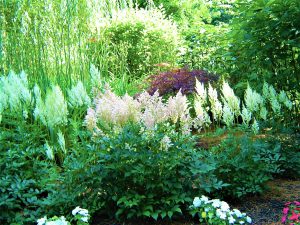By Linda Hagen, Garden Design, July 2019
We can all use a little extra hydration in the summer, and plants are certainly no exception. Are you watering yours correctly? At the right time? Often enough? Maybe too often? Here are 13 tips to help ensure your plants survive the heat of summer:
- Test the soil with your finger. Poke down a few inches near the stem to check the root zone. You can also use a soil moisture meter. Even if the surface seems dry, there may still be moisture below. If not, get the hose!
- Watering in the morning is best. This will allow the water to soak in before it evaporates from heat and dry wind, allows the leaves time to dry out if they get splashed, and plants will have the moisture to draw from during the heat of the day. Late afternoon is second best, just be sure the foliage will dry out before nighttime. Avoid watering in the heat of the day because water will evaporate much faster and any overspray on the leaves can cause them to burn.
- Water at the base of the plant with a watering wand, long-neck watering can, soaker hose, or drip system. Avoid getting the leaves, fruits, or vegetables wet to help prevent diseases that thrive on moisture, like powdery mildew.
- Wind dries out plants quickly from moisture lost through the foliage – the larger the leaves, the more moisture lost (think squash, cucumber, coral bells, etc.). Protect plants with barriers, such as a structure made with shade cloth or locate them out of wind-prone areas.
- Fruits and vegetables need consistent water to produce well. Don’t let them go completely dry before watering them again because this can cause problems like blossom end rot or cracked tomatoes.
- Containers dry out much faster than the ground and will need more frequent watering, especially if they are placed in full sun or exposed to wind.
- Apply a 2- to 3-inch layer of organic mulch, such as bark, pine needles, or shredded leaves. This will help hold moisture in the soil.
- If water puddles, apply a small amount to soften the surface. Come back a few minutes later and add more to make sure it soaks in thoroughly.
- Brown leaf edges and/or yellow leaves can signal over-watering. Make sure you’re checking before adding more.
- Plants benefit much more from a slow and deep watering than a quick splash. Make sure you’re watering deep enough to reach the root ball.
- If summer vacation is going to keep you away for more than a day or two, setting up an automatic timer will be well worth the effort. Or, check out garden and landscape maintenance at: https://recchilungolandscaping.com/services/landscape-maintenance/
- Recycle a plastic bottle as a deep watering system. Cut the bottom off and bury next to plants. Add water to the bottle through the top and the water will absorb deeper into the soil out the bottom of the bottle.
- Unglazed clay pots are more porous than glazed or plastic pots and allow water to evaporate faster. This may be good during wetter times of the year by allowing the soil to drain better and not get soggy, but keep an extra eye on them during a drought or hotter weather.

